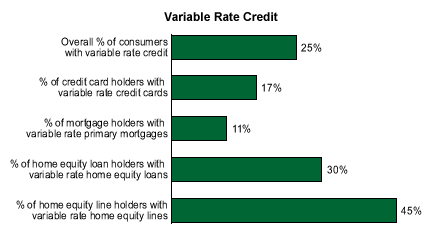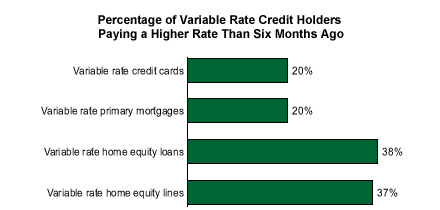Experian, a global information solutions company, and The Gallup Organization today released the benchmark results of their new monthly Personal Credit Index poll*. Among the key findings from the baseline survey: A fifth of consumers are already feeling the pinch of rising interest rates, which have caused them to cut back on their spending.
How can this be, with interest rates as low as they are today? The answer is that the change in interest rates is as important a factor in people's level of spending as is the absolute level of interest rates. And since June 2004, rates have increased six times.
Variable Rate Credit
Overall, about a quarter of all consumers have some type of variable or adjustable rate credit. Seventeen percent of consumers with credit cards say they have a variable rate credit card. A tenth of mortgage borrowers say they have an adjustable rate mortgage. Thirty percent of those with home equity loans and 45% of those with home equity lines of credit have a variable rate.

Experiencing Higher Rates
One in five consumers with a variable rate credit card or adjustable rate mortgage are paying a higher interest rate now than they did six months ago. More than a third of those with a variable rate home equity loan or line of credit have also experienced a rate increase during the past six months.

Cutting Back Spending
As noted, 20% of consumers say higher interest rates have caused them to cut back on their spending. As might be expected, the impact has been disproportionately felt by lower-income consumers. Twenty-nine percent of consumers with annual household incomes of less than $40,000 say they have had to cut back on their spending because of higher interest rates. About half as many consumers (17%) with incomes between $40,000 and $75,000 a year have cut their spending, while only 10% of those earning $75,000 or more annually have had to do so.

Poorly Perceived Consequences
Monetary policy-makers have increased interest rates six times since last June and their target rate now stands at 2.5%. Simultaneously, the Bank Prime Rate has also increased six times, going from 4.0% last June to 5.5% in February 2005. This rate is still low by historical standards; some economists will argue it is lower than the inflation rate and should continue to rise. The Federal Reserve Board seems to agree, as it has clearly stated its plan to keep increasing interest rates in the months ahead.
In the more mundane world of many average consumers, however, each increase means higher monthly payments. Numerous forms of variable consumer credit are tied to the Bank Prime Rate or a similar rate. As a result, many consumers who have variable rate borrowings have experienced -- and will continue to experience -- increased interest rates and increased monthly payments to service their debt.
One probable consequence is a more pronounced reduction in consumer spending than many economic observers currently anticipate. This is particularly likely for low- and moderate-income consumers and less likely for those who can afford an increase in their monthly credit payments.
Of even greater concern, however, is the potential threat significant interest rate increases may pose to many consumers' ability to manage their monthly payments. And this time around, much of the consumer debt that's at risk will be secured by people's homes -- a new situation for all of us.
*Results are based on telephone interviews with 2,007 national adults, aged 18 and older, conducted Jan. 17-23, 2005, and Feb. 2-7, 2005. For results based on the combined sample of 2,007, one can say with 95% confidence that the margin of sampling error is ±2.4 percentage points.
